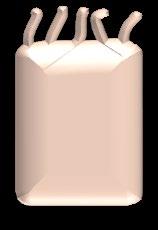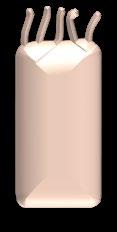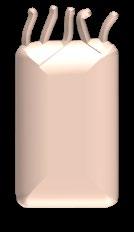
Educational Objectives

• Describe key pathophysiologic processes in severe asthma development and persistence, including the roles of TSLP and implications for treatment
• Discuss the clinical profiles and recent trial results with newer biologic therapies for severe asthma
• Construct biologic-based treatment regimens for patients with severe asthma to maximize asthma control, prevent exacerbations, and incorporate shared clinical decision making
TSLP, thymic stromal lymphopoietin.
UNDERLYING MECHANISMS IN SEVERE ASTHMA
 Michael E. Wechsler, MD, MMSc
Michael E. Wechsler, MD, MMSc

The Dynamic Airway Epithelium
The First Piece in the Sequence of Asthma Inflammation


vs
• Characteristics of the Asthma Airway:
– Inflammation
– Hyperreactivity
– Recurrent, reversible obstruction
• Contributing factors:
– Disruption of microbiome
–
Excessive goblet cell differentiation
– Excessive mucus production
–
–
Dysfunctional cilia movement

Disruption of TJ complexes leading to increased permeability APC, antigen-presenting cell; ILC, innate lymphoid cell; PRR, pattern recognition receptor; TJ, tight junction. Laulajainen-Hongisto A, et al. Front Cell Dev Biol. 2020;8:204.
Epithelial Cytokine Networks in Asthma
A Closer Look at T2-High-Driven Disease
Allergens
Irritants, pollutants, microbes, and viruses

T2-high cytokines1,2


– IL-4, IL-5, & IL-13
– Produced by Th2 and ILC2 cells





















Biomarkers1,2
–
Eosinophilia






































































–
Elevated IgE
–

Elevated FeNO












Atopic


























































Nonatopic


CRTH2, chemoattractant receptor-homologous molecule expressed on Th2 cells; DC, dendritic cell; DR3, death receptor 3; EC, endothelial cell; GATA3, GATA binding protein 3; GC, goblet cell; ILC2, innate lymphoid cell type 2; KIT, receptor tyrosine kinase; MHC, major histocompatibility complex; PGD2, prostaglandin D2; SM, smooth muscle; ST2, IL-33 receptor; T2, type 2; TCR, T cell receptor; TGR, transforming growth factor; Th, T-helper cell; TNF, tumor necrosis factor; TL1A, TNF-like protein 1A; TSLP, thymic stromal lymphopoietin. Image adapted from Corren J. J Allergy Clin Immunol Pract. 2019;7(5):1394-1403 and Israel

N
1. Kim H, et al.
Asthma Clin Immunol.
2. Lee Y, et al. Allergy Asthma Immunol Res
E, Reddel HK.
Engl J Med. 2017;377(10):965-976.
Allergy
2017;13:48;
. 2021;13(3):375-389.
Th2 cell GATA3 KIT IgE IL-4 Mast cell EC
GC TSLP IL-33 IL-25 DC B cell PGD2 MHC T cell TCR IL-4 TL1A DR3 IL-13 OX40L OX40 Eosinophil SM IL-5 IL-13 IL-13 ILC2 GATA3 BM TSLP IL-33 IL-25 ST2 TSLP-R CRTH2 33R IL IL-13
Tezepelumab Dupilumab Tezepelumab Dupilumab Benralizumab Mepolizumab Reslizumab Omalizumab
Mucus Plugging and Hypersecretion A Closer Look at T2-High-Driven Disease
Normal
Mucus hypersecretion

Asthma epithelium








Asthma GC ASM
• Substantial plugging in most patients with fatal asthma; persists in the same airways over time, increasing in frequency with disease severity1




• IL-13-mediated





– Proliferation of hypersecretory MUC5AC-expressing mucus cells2,3













– Loss of ciliated cells2





























































































– Increase in thiocyanate transport3

Eosinophil-rich mucus plug

Eosinophil exotaxis
• Thiocyanate reacts with eosinophil peroxidase, promoting cross-linking of mucins, mucus gel stiffening, and resultant mucus plug formation






– Activation of






































and release of granule proteins
Numerous studies, including case reports, post-hoc and meta-analysis, have explored the role of biologic therapies in the reduction of mucus plugging.
IL-13 IL-5
ASM, airway smooth muscle. 1. 6(12):112; 2. Seibold MA. 6(12):112. Bonser LR, Erie DJ. J Clin Med. 2017; Ann Am Thorac Soc. 2018;15(suppl 2):S98–S102; 3. Anai M, et al. Respirology Case Rep. 2022;11(1):e01074. Image adapted from Kavanaugh JE, et al. Breathe. 2021;17(4): 210144 and Bonser LR, Erie DJ. J Clin Med. 2017; Lumen MUC5B Cell Ciliated Cell Easily Transportable Mucus Gel Mucus Plug MUC5AC Cell MUC5AC-Tethering Airflow Obstruction
• IL-5-mediated
3
eosinophils
Epithelial Cytokine Networks in Asthma
A Closer Look at T2-Low Driven Disease
Alarmin-Mediated Inflammatory Pathways
• T2-low cytokines1-3

– IL-1β, IL-6, IL-8, IL-17, & TNF-α































– Produced by Th17 and Th1 cells













• No reliable biomarkers beyond absence of T2-high biomarkers






• Neutrophilic or paucigranulocytic














2.
et
J
3. Lambrecht BN, et al. Immunit
Image adapted from Corren J. J Allergy Clin Immunol Pract. 2019;7(5):1394-1403 and Israel E, Reddel HK. N Engl J Med. 2017;377(10):965-976. Th17 cell Neutrophil Th1 cell Irritants, pollutants, microbes, and viruses TSLP IL-33 IL-6 IL-23 GM-CSF IL-8 IL-17A IL-17E (IL-25) IFN-γ TNF-α CXCR2 Tezepelumab
GM-CSF, granulocyte–macrophage colony-stimulating factor; IFN, interferon. 1. Kalchiem-Dekel O, et al. Chest. 2020;157(1):26-33;
Hinks TSC,
al. Eur Respir
. 2021;57(1):2000528;
y. 2019;50(4):975-991.
Epithelial Cytokine Networks in Asthma
A Closer Look at T2-Low Driven Disease
IL-6-Mediated Airway Inflammation







Homeostasis
Infection

Tight Junctions











Exacerbations


• T2-low cytokines1-3 – IL-1β, IL-6, IL-8, IL17, & TNF-α









































– Produced by Th17 and Th1 cells



• No reliable biomarkers beyond absence of T2high biomarkers
• Neutrophilic or paucigranulocytic













MIP, macrophage inflammatory protein; MMP, matrix metalloproteinase; PAMP, pathogen-associated molecular pattern; TLR, toll-like receptor.






1. Kalchiem-Dekel O, et al. Chest. 2020;157(1):26-33; 2. Hinks TSC, et al. Eur Respir J. 2021;57(1):2000528; 3. Lambrecht BN, et al. Immunity. 2019;50(4):975-991.
Image adapted from Jevnikar Z, et al. J Allergy Clin Immunol. 2019;143(2):577-590.

IL-6
PAMPs Neutrophils
T
Compromised Barrier Function Amplified Antimicrobial Response Tissue Damage TLR Upgraded TLR Signaling
cells
IL-6 IL-8 IL-1β MIP-1β
MMP3
IL-6R
Macrophages sIL-6R
YKL-40
Submucosal Inflammation and Remodeling Eosinophilia IL-33 sIL-6R
shedding IL 6 Trans Signaling
Airway Smooth Muscle



The Final Common Pathway in Asthma
• ASM cells contribute to1
–
– Narrowing


–

– Remodeling
• ASM contraction releases mast cell mediators2
– Mast cell myositis is observed in various asthma phenotypes










































• ASM may also drive mucus hypersecretion3

Hyperresponsiveness
Inflammation
1. Camoretti-Mercado, Lockey
Ozier A, et al. J Allergy. Martin JG. Eur Respir J. 2018;52(2):1801166 Image adapted
J Allergy Clin Immunol. 2021; 147(6):1983-1995; 2. 2011;2011:742710; 3. . J Allergy Clin Immunol. 2021; 147(6):1983-1995. ASM tone Airway hyperresponsiveness & narrowing ASM mass increase Airway inflammation Airway remodeling Asthma Contractile agonists Secretion of chemokines, cytokines, & growth factors Environmental insults Allergens Compressed epithelium ASM ASM proliferation
RF.
from Camoretti-Mercado, Lockey RF.
Targeting Underlying Mechanisms of Disease
6 FDA-Approved Biologics for Asthma
Agent Target Indication(s)
Omalizumab IgE
• Moderate-to-severe, persistent asthma inadequately controlled with ICS; (+) skin test or in vitro reactivity to aeroallergen; age ≥6 years
• Symptomatic CSU despite H1AH; age ≥12 years
• Nasal polyps with inadequate response to INCS; age ≥18 years
Reslizumab IL-5
• Severe asthma, eosinophilic phenotype; age ≥18 years
• Severe asthma, eosinophilic phenotype; age ≥6 years
Mepolizumab IL-5
• CRSwNP; age ≥18 years
• EGPA; age ≥18 years
• HES that lasts for ≥6 months without identifiable nonhematologic secondary cause; age ≥12 years
Benralizumab IL-5Rα
• Severe asthma, eosinophilic phenotype; age ≥12 years
• Moderate-to-severe asthma, eosinophilic phenotype OR OCS-dependent; age ≥6 years
Dupilumab IL-4Rα
• Inadequately controlled CRSwNP; age ≥18 years

• Moderate-to-severe atopic dermatitis inadequately controlled with topical therapy OR contraindication to topical therapy; age ≥6 years
Tezepelumab TSLP
• Severe asthma; age ≥12 years
H1AH, oral H1-antihistamine; CRSwNP, chronic rhinosinusitis with nasal polyps; CSU, chronic spontaneous urticaria; EGPA, eosinophilic granulomatosis with polyangiitis; FDA, US Food and Drug Administration; HES, hypereosinophilic syndrome; ICS, inhaled corticosteroids; IgE, immunoglobulin E; IL, interleukin; INCS, intranasal corticosteroids; OCS, oral corticosteroid; R, receptor; SA, severe asthma. Drugs @ FDA. https://www.accessdata.fda.gov/scripts/cder/daf/.
Biologic therapies have revolutionized the treatment of severe asthma by reducing asthma exacerbations as demonstrated in randomized placebo-controlled trials.
NEWER THERAPEUTIC TARGETS IN SEVERE ASTHMA Monica

Kraft, MD

Newer Therapeutic Targets in Asthma
Target Mechanism Agent Stage of Development
• Tezepelumab, anti-TSLP
• Ecleralimab, inhaled anti-TSLP
• Itepekimab, anti-IL-33
Alarmins
TSLP IL-33 IL-25
• Epithelial tissue damage → release of alarmins (epithelial cell-derived cytokines) → drives inflammatory responses by activating dendritic cells and mast cells
• Etokimab, anti-IL-33
• FDA Approved
• Phase 2a – Terminated in Asthma

• Phase 2 – Completed; Development Terminated in Asthma; Investigations in COPD Ongoing
• Phase 2a – Completed
• Phase 2b/3 – Ready; No Further Internal Investment
• Astegolimab, anti-ST2 (IL-33 receptor)
Mast cells
• IgE cross-linking → Mast cell degranulation → mediators including histamine, tryptase, chymase, carboxypeptidase Th1
• Obesity/granulocytes → IL-6 → steroid-resistant inflammation
IL-6
• IL-6 trans-signaling: bacteria → TLRs → granulocytes shed soluble IL-6R + IL-6 → local epithelial cell inflammations
• Masitinib, TKI
• Imatinib, TKI
• Tocilizumab, anti-IL-6R
• Sirukumab
• Phase 2b – Completed; Development Terminated in Asthma; Investigations in COPD Ongoing
• Phase 3 – Completed
• Phase 2 – Completed
• Off-label Case Studies
• Phase 2a – Withdrawn Prior to Participant Enrollment
COPD, chronic obstructive pulmonary disease. TKI, tyrosine kinase . Hinks TSC, et al. Eur Respir J. 2021;57(1):2000528; Wechsler ME. Respir Care. 2018;63(6):699-707; E, et al. . 2020;75(2):311325; Clinicaltrials.gov. https://clinicaltrials.gov/ct2/home. 6, 2023; Esty B, et al.
inhibitor
Kelson SG, et al. J Allergy Clin Immunol. 2021;148(3):790798;
Sze Allergy Accessed February J Allergy Clin Immunol Pract. 2019;7(5): 1639–1642.e4; Press release. https://ir.anaptysbio.com/news-releases/news-release-details/anaptysbio-presents-updated-data-etokimab-phase-2a-proof-concept. Accessed April 25, 2023.
Tezepelumab – Anti-TSLP






Pivotal Phase 3 Navigator Trial1
Annualized Rate of Exacerbations
• SAFETY – Serious AE
• Tezepelumab, 9.8%

• Placebo, 13.7%
• Reductions from baseline in blood
eosinophil counts and FeNO levels were also observed
aP<0.001 vs placebo. AE, adverse event; Q4W, every 4 weeks; RR, relative reduction; SQ, subcutaneous. N=1061 patients aged 12- 80 years with severe uncontrolled asthma requiring medium- or high-dose ICS (daily dose of ≥500 μg of fluticasone propionate or equivalent) plus ≥1 controller medication with/without OCS were randomized 1:1 to tezepelumab 210 mg SQ (n=529) or placebo (n=532) Q4W for 52 weeks. The primary endpoint was reduction in annualized exacerbation rates.
1. Menzies-Gow A, et al. N Engl J Med. 2021;384(19):1800-1809; 2. Pharmacy Times. https://www.pharmacytimes.com/view/fda-approves-pre-filled-pen-for-self-administration-of-tezepelumab-ekko-to-treat-asthma.
Accessed February 6, 2023; 3. European Pharmaceutical Review (EPR). https://www.europeanpharmaceuticalreview.com/news/178513/pre-filled-asthma-auto-injector-pen-approved-for-self-administration-in-eu/. Accessed January 23, 2023.
Rate 2.1 2.66 2.24 1.7 0.93a 0.79 0.89 1.04 0.0 0.5 1.0 1.5 2.0 2.5 3.0 Overall Population ≥300 cells/μL ≥150 cells/μL <150 cells/μL Placebo Tezepelumab 210 mg 56 RR % 61 RR % 70 RR % 39 RR % Tezepelumab recently gained approval for self-administration.2,3
Other Tezepelumab Studies
Study Details Results

DESTINATION1
• Long-term extension study of tezepelumab in adults and adolescents with severe uncontrolled asthma who completed the NAVIGATOR or SOURCE studies (Phase 3)
• Sustained reductions in AAER over 104 weeks vs placebo of 58% (NAVIGATOR) and 39% (SOURCE); reduced biomarker levels vs placebo; overall long-term safety and efficacy consistent with the previous studies.
PASSAGE2
• Real-world effectiveness and safety study of tezepelumab in a broad population of adults and adolescents with severe asthma, including underrepresented patients in clinical trials (Phase 4)
WAYFINDER3
• Study to Evaluate Efficacy and Safety of Tezepelumab in Reducing Oral Corticosteroid Use in Adult Patients With Severe Asthma
(Phase 3)
• Ongoing
• Ongoing
AAER, annualized asthma exacerbation rate. 1. Menzies-Gow A, et al. DESTINATION: tezepelumab long-term safety and efficacy versus placebo in patients with severe, uncontrolled asthma. European Respiratory Society (ERS) International Congress 2022, Oral Presentation OA9002, https://s3.eu-central-1.amazonaws.com/m-anage.com.storage.ers/abstract_2022/95944.html.pdf; 2. Lugogo N, et al. CHEST; 2022;162(4):A37A40. https://journal.chestnet.org/article/S0012-3692(22)01383-6/fulltext; 3. Clinicaltrials.gov. Study to Evaluate Efficacy and Safety of Tezepelumab in Reducing Oral Corticosteroid Use in Adult Patients With Severe Asthma (WAYFINDER). Available at https://clinicaltrials.gov/ct2/show/NCT05274815. Accessed January 23, 2023.
Itepekimab – Anti-IL-33 Phase






























2 Study
Loss of Asthma Control Change in Eosinophil Count



Weeks Since Randomization
Weeks Since

While development of itepekimab has been discontinued in asthma, studies investigating its efficacy/safety in COPD are ongoing.
















aOR=0.52 vs placebo; bOR=0.42 vs placebo; cOR=0.33 vs placebo; OR, odds ratio; Q2W, every 2 weeks. N=296 adult patients with moderate-to-severe asthma receiving inhaled glucocorticoids plus LABAs received (1:1:1:1) itepekimab 300 mg SQ (n=73), itepekimab plus dupilumab, both 300 mg SQ (n=74), dupilumab 300 mg SQ (n=74), o r placebo (n=74) Q2W for 12 weeks. LABA was discontinued at week 4 and inhaled glucocorticoids were tapered over weeks 6 through 9.
Wechsler ME, et al. N Engl J Med. 2021;385(18):1656-1668.
ICS Taper -250 -200 -150 -100 -50 0 50 100 150 200 250 300 350 400 0 2 4 6 8 10 12 Dupilumab Itepekimab Placebo Itepekimab+dupilumab Δ From Baseline in Eosinophil Count, cells/ μ L
Randomization LABA Withdrawal Cumulative Incidence, % 0 10 20 30 40 50 0 2 4 6 8 10 12 LABA Withdrawal ICS Taper
b a c
Etokimab – Anti-IL-33 Phase






































2a Proof-of-Concept Study
While positive Phase 2a trial results were positive, further internal investigation has been discontinued.































IV, intravenously. N=25 adults with severe asthma, blood eosinophils ≥300 cells/µL, pre-bronchodilator FEV1 <80% of predicted, and ≥1 asthma exacerbation within the past 12 months requiring use of rescue medication were randomized to etokimab 300 mg IV or placebo. Press release. https://ir.anaptysbio.com/news-releases/news-release-details/anaptysbio-presents-updated-data-etokimab-phase-2a-proof-concept.
Accessed April 25, 2023.

-50 -40 -30 -20 -10 0 10 20 0 2 8 22 36 64 85 106 127 Etokimab Placebo
% Change in Blood Eosinophil Level From Baseline 0 5 10 15 20 0 2 82 22 36 64 85 106 127 Etokimab Placebo
% Change in FEV 1 From Baseline
Days Since Randomization
Days Since Randomization
Astegolimab – Anti-ST2













IL-33 Receptor Monoclonal Antibody─Phase 2b Study
While development of astegolimab has been discontinued in asthma, studies investigating its efficacy/safety in COPD are ongoing.
AER, asthma exacerbation rate. N=502 adults with severe asthma randomized to 70 mg, 210 mg , or 490 mg SQ astegolimab or placebo for 4 weeks until week 54. Kelsen SG, et al. J Allergy Clin Immunol. 2021;148(3):790-798.
Annualized AER Overall Eos
Eos
0.0 0.1 0.2 0.3 0.4 0.5 0.6 0.7 0.8 Placebo 70 210 490 Astegolimab (mg) 35.1% 27% 41.9% 0.0 0.1 0.2 0.3 0.4 0.5 0.6 0.7 0.8 Placebo 70 210 490 Astegolimab (mg) 26.1% 13% 42% 0.0 0.1 0.2 0.3 0.4 0.5 0.6 0.7 0.8 Placebo 70 210 490 Astegolimab (mg) 41% 42.3% 41%
<150
≥150
Phase 3 Study in OCS-dependent SA







Primary analysis; no minimum baseline blood eos
Masitinib reduced severe asthma exacerbations and demonstrated a positive benefit/risk ratio in patients with severe asthma uncontrolled by OCS, irrespective of baseline eosinophil count.
=0.01; bP=0.025. eos, eosinophils. N=355 adult patients (primary population) with severe persistent asthma uncontrolled by OCS (≥7.5 mg/day) and high-dose ICS/LABA were randomized 2:1 to oral masitinib (6 mg/kg/day) or placebo for 36 weeks. The primary endpoint was reduction of annualized asthma exacerbation rate adjusted for overall exposure. Davidescu L, et al. J Asthma Allergy. 2022;15:737-747.
Masitinib – TKI
Exacerbation
Asthma Exacerbation Rate aP
Annualized Severe Asthma
Rate Annualized Moderate/Severe
0.48 0.34a 0.0 0.1 0.2 0.3 0.4 0.5 0.6 Placebo (n=115) Masitinib (n=240) 35 RR % Subgroup analysis; blood eos ≥150 cells/µL Annualized AER 0.71 0.48b 0.0 0.2 0.4 0.6 0.8 Placebo (n=87) Masitinib (n=181) 38 RR %
Imatinib – TKI



Phase 2 Proof-of-Principle Study

Airway Hyperresponsiveness
Total Tryptase Levels in Serum
Imatinib increased the methacholine PC20 by a mean of 1.20 doubling doses from baseline to month 3 and by 1.73 doubling doses from baseline to month 6.
Evidence of mast cell activity was also reduced per decreased tryptase levels.
QD, once daily; PC20, concentration of methacholine required to decrease the forced expiratory volume in 1 second by 20%. N=62 adult patients with severe refractory asthma uncontrolled by beclomethasone (>960 µg/day) or equivalent were randomized 1:1 to imatinib (200 mg QD for 2 weeks then 400 mg QD thereafter) or placebo for 24 weeks. The primary endpoint was change in airway hyperresponsiveness, assessed as methacholine reactivity (PC20), from baseline to 3 and 6 months. Cahill KN, et al. N Engl J Med. 2017;376(20):1911-1920.
0 1 2 3 4 5 6 Baseline Month 6 Placebo Imatinib Change in Methacholine Reactivity PC 20 (doubling doses) Tryptase Level (ng/mL) -1 0 1 2 3 Baseline Month 3 Month 6 Placebo Imatinib P=0.03 P=0.94 P=0.08 P=0.08 P=0.02
CHALLENGES SURROUNDING BIOLOGIC THERAPIES

Timing of Initiation, Predictors of Response, & Individualized Selection
Michael E. Wechsler, MD, MMSc

State of OCS Use in Severe Asthma
Results From a 14-year Population-Based Study
8.2%

Number of follow-up periods associated with maintenance OCS use1
Results from the International Severe Asthma Registry . . .
Number of follow-up periods associated with ≥1 episode of OCS use1
At least 30% of SA patients with high OCS exposure do not receive a biologic2
75% Patients with SA continue to have substantial exposure to OCS as episodes of increased respiratory symptoms are ubiquitously managed with courses of OCS.3
1. Sadatsafavi M, et al. Respir Res. 2021;22:103; 2. Chen Wet al. J Asthma Allergy. 2022;15:1491-1510; 3. Tran TN, et al. J Allergy Clin Immunol Pract. 2021;9(1):338-346.e3.
•
OCS-Related Toxicities in Asthma
Infections
Weight gain
Fractures
• OCS-related risk increases in a dose-dependent manner4
• Evidence suggest that T2
biomarker low asthma
symptoms do not benefit from OCS5

What Can Be Done Differently to Reduce OCS Exposure?
As little as 1 course of OCS/year on top of background high-dose ICS results in a statistically significant increase in OCS -induced morbidity.5
Affected1-4
Numerous Body Systems
VTE, venous thromboembolism.
2.
2018;141(1):110-116.e7; 3.
4.
J Manag Care Spec Pharm
2016;22(7):833-847; 5.
disease
apnea
1. Sweeney J, et al. Thorax. 2016;71(4):339-346;
Sullivan PW, et al. J Allergy Clin Immunol.
Price DB, et a. J Asthma Allergy. 2018;11:193-204;
Dalal AA, et al.
.
McDowell PJ, et al. Curr Treat Options Allergy. 2023;10:53-63. Cerebrovascular
Cataracts Sleep
Bruising
VTE Depression Anxiety Insomnia Acne
impairment
Muscle mass loss
Dyspeptic disorders Hypertension T2DM Renal
Adrenal insufficiency Osteoporosis And more…
CHRONICLE Study in SA
Ongoing Real-World Observational Study
Interim Report (Genofre, February 2021)1
• N=959 patients with confirmed SA analyzed
–
59% had an exacerbation while not receiving biologics
–
Of these, 41% subsequently initiated biologic therapy
– The median number of days between last exacerbation and biologic initiation was 70 days for patients with 1 exacerbation vs 36.5 days for patients with ≥1 exacerbation (P<0.05)
Interim Report (Chipps, February 2022)2
• N=908 patients with confirmed SA, biologic use for ≥12 months analyzed
–
68% had no OCS use within the most recent 12 months

–
35% had majority of monthly ACT scores ≥20 and patient- and specialist-reported asthma control
ACT, Asthma Control Test. 1. Genofre E, et al. Ann Allergy Asthma Immunol. 2021;127(5):S37-S38; 2. Chipps B, et al. J Allergy Clin Immunol. 2022;149(suppl 2): AB147.
Expediting access to biologic therapy for patients with uncontrolled SA should be explored.
ICS Dose Response Curve

Efficacy and Adverse Effects
Relationship of Fluticasone Propionate dose, clinical effect, and risk of systemic side effects
200-250 μg of FP or equivalent is the dose at which 80–90% of the maximum achievable therapeutic benefit is obtained in adult asthma across the spectrum of severity
FP, fluticasone propionate; PEF, peak expiratory flow. Beasley R, et al. Am J Resp Crit Care Med.
% of Maximum Clinical Effect 250 500 750 Daily Dose of Fluticasone Propionate, μg Medium Dose High Dose 100 80 60 40 20 % Increase in Risk of Systemic Side Effect Efficacy outcome FEV1 Morning PEF Evening PEF Use of rescue medication Major exacerbations Night awakenings Systemic side effect Adrenal insufficiency Cataracts Nonvertebral fracture Diabetes 1000 70 60 50 40 30 20 10 0 Low Dose 0 0
2019;199(12):1471-1477.
Results From an Online Survey

Premeeting Clinician Poll
Which of the following challenges do you commonly experience when using biologic therapies to treat severe asthma?
Insufficient efficacy
Adverse reactions
Polypharmacy and comorbid disease
Switching biologics
Biomarkers
Patient reluctance
Selection of initial biologic

Insurance denial/access barriers
• 24% Allergy/Immunology
• 42% Family or Internal Medicine
• 33% Pulmonology
0% 10% 20% 30% 40% 50% 60% 70% 80%
N=45; data collected from
clinicians
severe asthma.
practicing
who manage
DISPARITIES IN BIOLOGIC UTILIZATION

Considerations for Overcoming Barriers to Asthma Care

Monica Kraft, MD
The State of Biologic Use in Severe Asthma
1M patients have severe asthma in the US1
40% (400K) have been seen by a specialist2
65% (260K) are prescribed a biologic3

35% (140K) are not on a biologic despite uncontrolled SA or chronic OCS use3
60% (600K) are assumed to be managed by primary care
1. American Lung Association. Severe Asthma. Available at https://www.lung.org/lung-health-diseases/lung-disease-lookup/asthma/learn-about-asthma/types/severeasthma#:~:text=Of%20the%20more%20than%2025,by%20the%20frequency%20of%20symptoms. Accessed January 23, 2023; 2. Most JF, et al. J Allergy Clin Immunol Pract. 2021;9(10):3662-3671; 3. Panettieri RA Jr, et al. Ann Allergy Asthma Immunol. 2022;129(4):467−474; 4. Mayo Clinic. Big data helps in understanding asthma biologic use, outcomes. Available at https://advancingthescience.mayo.edu/2022/01/06/bigdata-helps-in-understanding-asthma-biologic-use-outcomes/. Accessed May 16, 2023.
Almost all of asthma biologics prescribed in the US are prescribed by specialists, and those specialists are more accessible to certain groups of people than others.4
Disparities in Biologic Use in the US
Patients with the highest rate of receiving biologic therapy1:
White, adult females
Annual income of >$75,000

Managed by specialist
Patients with highest rate of asthma mortality and ED visits due to asthma2:
Black, adult females Black, Hispanic, and Indigenous individuals in the US face the highest burden of asthma compared with White Americans.

between the number of

receiving
ED, emergency department. 1. Inselman JW, et al. J Allergy Clin Immunol Pract. 2020;8(2):549-554.e1; 2. AAFA. Asthma Disparities in America. Available at https://aafa.org/asthma-allergy-research/ourresearch/asthma-disparities-burden-on-minorities/#:~:text=The%20burden%20of%20asthma%20in,asthma%20rates%2C%20deaths%20and%20hospitalizations. Accessed January 1, 2023; 3. Burchard EG, Borrell LN. N Engl J Med. 2021; 385(24):2297-2298; 4. Mayo Clinic. Big data helps in understanding asthma biologic use, outcomes. . Available at https://advancingthescience.mayo.edu/2022/01/06/big-data-helps-inunderstanding-asthma-biologic-use-outcomes/. Accessed May 16, 2023.


Although biologic therapies represent a new dawn in medical care, the benefits are not accessible to all patients.3 There is a clear gap
people
biologics and those who would benefit from these therapies.4
Factors Contributing to Disparities in Biologic Use
Race and Ethnicity1

Biological Behavioral Sociocultural Environmental
Genetics
Nutrition Smoking
Microbiome
Diet
Education
Socioeconomic Status
Health Insurance

Health Literacy
Therapy Adherence
Psychosocial Stressors
Environmental and Health System
• Severe and poorly controlled asthma disproportionately affects the Black population2
– Asthma mortality is 4x as high among Puerto Ricans and Black Americans as among White Americans
Housing
Neighborhood
Quality of Indoor Air
Outdoor Air/Pollution
Access to Health Care
Access to Quality Foods
• Black and Hispanic populations represent only 5% and <1% of clinical trial participants, respectfully2

1. Perez MF, Coutinho MT. Yale J Biol Med. 2021;94(3):497-507; 2. Burchard EG, Borrell LN. N Engl J Med. 2021; 385(24):2297-2298.
Health disparities, including access to biologics, are multifactorial.
The lack of racial and ethnic diversity limits the generalizability of trial results.2
Conclusions
• 6 biologic therapies are available for the treatment of severe asthma
• Despite revolutionizing the treatment of severe asthma, unmet needs and health care disparities persist with respect to biologic agent utilization
• Current challenges include:
–

Initial biologic selection, monitoring, switching, and access
• As precision medicine continues to evolve, we look ahead to: – Explore newer treatment targets
– Define biomarker thresholds and refine treatment eligibility
– Investigate outcomes in broader, underserved patient populations



 Michael E. Wechsler, MD, MMSc
Michael E. Wechsler, MD, MMSc



















































































































































































































































































































































































